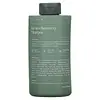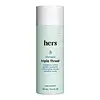What's inside
What's inside
 Key Ingredients
Key Ingredients

 Benefits
Benefits

 Concerns
Concerns

 Ingredients Side-by-side
Ingredients Side-by-side

Water
Skin ConditioningDisodium Laureth Sulfosuccinate
CleansingCoco-Betaine
CleansingLauryl Glucoside
CleansingCocamide Mipa
EmulsifyingSodium Cocoyl Isethionate
CleansingAcacia Concinna Fruit Extract
Skin ConditioningLactobacillus/Rice Ferment
Skin ConditioningBiotin
AntiseborrhoeicPanthenol
Skin ConditioningCocos Nucifera Oil
MaskingCaffeine
Skin ConditioningMelaleuca Alternifolia Leaf Oil
AntioxidantMentha Piperita Oil
MaskingCurcuma Longa Leaf Extract
Skin ConditioningPanax Ginseng Root Extract
EmollientNiacinamide
SmoothingRosmarinus Officinalis Leaf Oil
MaskingAcorus Calamus Root Extract
PerfumingCamellia Sinensis Leaf Extract
AntimicrobialCitrus Paradisi Fruit Extract
Skin ConditioningSimmondsia Chinensis Seed Oil
EmollientMalt Extract
Skin ProtectingPrunus Amygdalus Dulcis Oil
Skin ConditioningArgania Spinosa Kernel Oil
EmollientPlukenetia Volubilis Seed Oil
EmollientMacadamia Ternifolia Seed Oil
EmollientTocopheryl Acetate
AntioxidantMenthol
MaskingHydrolyzed Collagen
EmollientHydrolyzed Keratin
HumectantCeramide NP
Skin ConditioningCitric Acid
BufferingStyrene/Acrylates Copolymer
Polyquaternium-10
Hydroxyacetophenone
AntioxidantParfum
MaskingCitral
PerfumingLimonene
PerfumingWater, Disodium Laureth Sulfosuccinate, Coco-Betaine, Lauryl Glucoside, Cocamide Mipa, Sodium Cocoyl Isethionate, Acacia Concinna Fruit Extract, Lactobacillus/Rice Ferment, Biotin, Panthenol, Cocos Nucifera Oil, Caffeine, Melaleuca Alternifolia Leaf Oil, Mentha Piperita Oil, Curcuma Longa Leaf Extract, Panax Ginseng Root Extract, Niacinamide, Rosmarinus Officinalis Leaf Oil, Acorus Calamus Root Extract, Camellia Sinensis Leaf Extract, Citrus Paradisi Fruit Extract, Simmondsia Chinensis Seed Oil, Malt Extract, Prunus Amygdalus Dulcis Oil, Argania Spinosa Kernel Oil, Plukenetia Volubilis Seed Oil, Macadamia Ternifolia Seed Oil, Tocopheryl Acetate, Menthol, Hydrolyzed Collagen, Hydrolyzed Keratin, Ceramide NP, Citric Acid, Styrene/Acrylates Copolymer, Polyquaternium-10, Hydroxyacetophenone, Parfum, Citral, Limonene
Water
Skin ConditioningCocamidopropyl Betaine
CleansingLauric Acid
CleansingDecyl Glucoside
CleansingSodium Chloride
MaskingDisodium Cocoamphodiacetate
CleansingParfum
MaskingAcrylates Copolymer
Glycerin
HumectantPotassium Hydroxide
BufferingPolysorbate 20
EmulsifyingGuar Hydroxypropyltrimonium Chloride
Skin ConditioningGlycol Distearate
EmollientCocamidopropyl Dimethylamine
EmulsifyingSalicylic Acid
MaskingGlyceryl Oleate
EmollientCoco-Glucoside
CleansingPolyquaternium-67
Cucurbita Pepo Seed Oil
EmollientCamellia Sinensis Leaf Extract
AntimicrobialGeraniol
PerfumingSteareth-4
EmulsifyingChlorphenesin
AntimicrobialBenzyl Salicylate
PerfumingPEG-120 Methyl Glucose Dioleate
EmulsifyingCitronellol
PerfumingCarya Ovata Bark Extract
Skin ConditioningCitric Acid
BufferingSodium Benzoate
MaskingAmyl Cinnamal
PerfumingBiotin
AntiseborrhoeicSodium Acetate
BufferingSerenoa Serrulata Fruit Extract
Skin ConditioningIsopropyl Alcohol
SolventPhenoxyethanol
PreservativeTocopherol
AntioxidantBenzoic Acid
MaskingDehydroacetic Acid
PreservativeHydrogenated Palm Glycerides Citrate
EmollientLecithin
EmollientAscorbyl Palmitate
AntioxidantWater, Cocamidopropyl Betaine, Lauric Acid, Decyl Glucoside, Sodium Chloride, Disodium Cocoamphodiacetate, Parfum, Acrylates Copolymer, Glycerin, Potassium Hydroxide, Polysorbate 20, Guar Hydroxypropyltrimonium Chloride, Glycol Distearate, Cocamidopropyl Dimethylamine, Salicylic Acid, Glyceryl Oleate, Coco-Glucoside, Polyquaternium-67, Cucurbita Pepo Seed Oil, Camellia Sinensis Leaf Extract, Geraniol, Steareth-4, Chlorphenesin, Benzyl Salicylate, PEG-120 Methyl Glucose Dioleate, Citronellol, Carya Ovata Bark Extract, Citric Acid, Sodium Benzoate, Amyl Cinnamal, Biotin, Sodium Acetate, Serenoa Serrulata Fruit Extract, Isopropyl Alcohol, Phenoxyethanol, Tocopherol, Benzoic Acid, Dehydroacetic Acid, Hydrogenated Palm Glycerides Citrate, Lecithin, Ascorbyl Palmitate
Ingredients Explained
These ingredients are found in both products.
Ingredients higher up in an ingredient list are typically present in a larger amount.
Biotin is a B vitamin that is naturally produced by our bodies. It is also called Vitamin H.
Our bodies use biotin in the metabolism process. It also helps our bodies use enzymes and move nutrients around. A biotin deficiency can lead to brittle hair and nails.
More research is needed on applying biotin topically. However, taking biotin orally has been shown to help nourish the skin, hair, and nails. They play a role in forming skin-hydrating fatty acids.
Biotin is water-soluble. It can be found in foods such as fish, eggs, dairy, nuts, and meat. Vitamin H stands for "haar" and "haut". These are the German words for hair and skin.
Learn more about BiotinCamellia Sinensis Leaf Extract is derived from the leaves of the tea plant. Black tea, green tea, and oolong tea are all harvested from this plant.
This ingredient has many skin benefits:
This ingredient contains polyphenols, a strong antioxidant. Antioxidants help fight off molecules that damage skin cells.
On top of that, the antioxidants in green tea neutralize free-radicals from the sun. This gives the skin some extra UV protection, but should not replace sunscreen.
Many components of tea have anti-inflammatory properties.
Polyphenols and L-theanine help soothe the skin and reduce irritation. The caffeine in Camellia Sinensis Leaf Extract helps calm inflamed blood vessels.
Other compounds found in tea include: Vitamin Bs, linoleic acid, magnesium, calcium, iron, and zinc.
Research has shown both drinking Camellia Sinensis Leaf Tea and applying it to the skin can help boost skin elasticity and hydration. Studies also show using tea extract may reduce sebum, or oil, production.
Learn more about Camellia Sinensis Leaf ExtractCitric Acid is an alpha hydroxy acid (AHA) naturally found in citrus fruits like oranges, lemons, and limes.
Like other AHAs, citric acid can exfoliate skin by breaking down the bonds that hold dead skin cells together. This helps reveal smoother and brighter skin underneath.
However, this exfoliating effect only happens at high concentrations (20%) which can be hard to find in cosmetic products.
Due to this, citric acid is usually included in small amounts as a pH adjuster. This helps keep products slightly more acidic and compatible with skin's natural pH.
In skincare formulas, citric acid can:
While it can provide some skin benefits, research shows lactic acid and glycolic acid are generally more effective and less irritating exfoliants.
Most citric acid used in skincare today is made by fermenting sugars (usually from molasses). This synthetic version is identical to the natural citrus form but easier to stabilize and use in formulations.
Read more about some other popular AHA's here:
Learn more about Citric AcidParfum is a catch-all term for an ingredient or more that is used to give a scent to products.
Also called "fragrance", this ingredient can be a blend of hundreds of chemicals or plant oils. This means every product with "fragrance" or "parfum" in the ingredients list is a different mixture.
For instance, Habanolide is a proprietary trade name for a specific aroma chemical. When used as a fragrance ingredient in cosmetics, most aroma chemicals fall under the broad labeling category of “FRAGRANCE” or “PARFUM” according to EU and US regulations.
The term 'parfum' or 'fragrance' is not regulated in many countries. In many cases, it is up to the brand to define this term.
For instance, many brands choose to label themselves as "fragrance-free" because they are not using synthetic fragrances. However, their products may still contain ingredients such as essential oils that are considered a fragrance by INCI standards.
One example is Calendula flower extract. Calendula is an essential oil that still imparts a scent or 'fragrance'.
Depending on the blend, the ingredients in the mixture can cause allergies and sensitivities on the skin. Some ingredients that are known EU allergens include linalool and citronellol.
Parfum can also be used to mask or cover an unpleasant scent.
The bottom line is: not all fragrances/parfum/ingredients are created equally. If you are worried about fragrances, we recommend taking a closer look at an ingredient. And of course, we always recommend speaking with a professional.
Learn more about ParfumWater. It's the most common cosmetic ingredient of all. You'll usually see it at the top of ingredient lists, meaning that it makes up the largest part of the product.
So why is it so popular? Water most often acts as a solvent - this means that it helps dissolve other ingredients into the formulation.
You'll also recognize water as that liquid we all need to stay alive. If you see this, drink a glass of water. Stay hydrated!
Learn more about Water